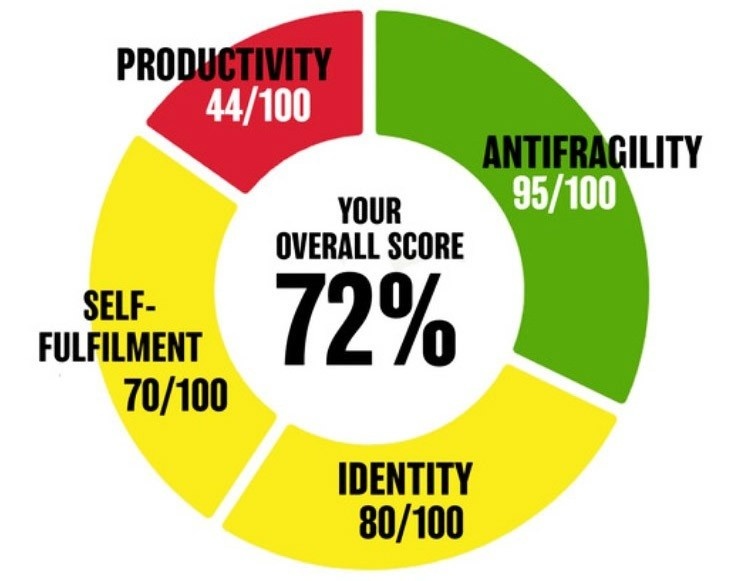Save
SUMMARY
- According to research presented in the book The One Thing, the average person loses 28% of their work day to “multi-tasking ineffectiveness”. Apply that 28% daily loss to 46 working weeks and you’ve lost 13 weeks, every single year!
- It’s no wonder people feel behind and over-worked. Instead of playing the game with 4 quarters per year, they’re trying to do it in 3. The key to getting that quarter back is simple – you just need to focus on single-tasking, instead of multi-tasking
- To implement single-tasking properly, you first need to know what you should be working on. The best time to do this is the night before so try picking out your top 3 tasks for the next day, when you stop working.
- You’ll also need to create time blocks throughout your day where you only focus on those critical tasks, without being interrupted by meetings, phone calls or other distractions.
- The final thing to do is to use a good old-fashioned time sheet to track your time. This will help you become conscious of the number of times you actually switch tasks in a given day (the average number in an hour is 37 times!)
- As you become more aware of your task-switching, and start staying with tasks for longer, you’ll gradually start adding back more and more lost time.
TRANSCRIPT
Have you ever felt there’s not enough hours in your day? Or your day is just full of busy work and not enough work on what matters most? Maybe you’re just pulling your hair out, because you’re not getting the things done that you want to get done? I’m Eric. Today I want to talk to you about productivity and how I’ve had many struggles in this exact same area. As a matter of fact, 10 years ago, I considered myself the world’s number one, procrastinator. I still had success, but all of that success constantly came with just way too much pain. It was way too difficult. And I struggled, you know, I had a real hard time maintaining focus, minimizing distractions, and really getting any work done. It was just the same story going over and over and over again. I would be sitting there with a project and thinking about all the things that I needed to do related to that project, and sure enough days would pass and I’d get closer and closer to the delivery date, and I still wasn’t getting the work done that I needed to get done.
Suddenly it’s the day before and I’m getting frantic and overwhelmed. Now I’m up till 2:00 AM and the project is finally finished, but the next day I’m feeling completely exhausted, handing it in or delivering it, whatever the situation was at the time, and just not feeling my best. Maybe you can relate to this; maybe you felt like this with certain things in life. Maybe you felt like it’s just all too hard. Like it’s pushing water uphill. It doesn’t have to be that way. 10 years ago, I started a search. I started a search for determining how I can transition from being this ultimate procrastinator in my mind, to a super producer who I am today. And that search process led me through hundreds of books and interviews and listening to various experts talk about procrastination and what you need to do to overcome procrastination.
But I’m not going to go through all of that today because well, frankly, we don’t have time to do all of that today. I’m just going to take you through just one simple golden nugget on this topic that really transformed my life. It came through in a book that I read called The One Thing. And in that book, they had this small quote, which said that the average worker loses 28% of their workday to multitasking ineffectiveness. Now, what is multitasking ineffectiveness? This is the simple fact that, very often, we’re doing more than one thing at a time or from task to task. We think we’re being effective, but we’re actually taking longer to do things than we even realize. Multitasking ineffectiveness is essentially jumping around from one job to the next, and that’s what’s accounting for a 28% loss in a workday.
If you extrapolate that up into the work weeks in a year, it’s 13 weeks being lost every single year. So if the average person is losing what amounts to an entire quarter every year, what does that mean? That means that the average person who’s worried about their productivity, doesn’t feel like they have enough time in their day. It’s only playing with three quarters in the year instead of four. So then the question is, “Well, what could you do if you had an extra quarter in your life, if you had an extra 13 weeks?” Today I want to tell you about my solution – how I came up with a way to add back 13 weeks to my life every single year, and feel a lot more productive because I had a lot more time. Who doesn’t want 13 weeks added back to back to their life, if you can get it?
And by the way, if you extrapolate that out even a little bit further, if we take 13 weeks a year, and if you take that out over an entire professional career of 40 years, you’re talking about an extra decade that you can capture here. What could you do with an extra decade? What hobbies might you pick up? What more work might you do? What more time might you spend with your family? That’s what’s on the table here and that’s what I want to help you capture. How do we capture all of this by mastering the art of single tasking? Single tasking is the antidote to multitasking ineffectiveness. How do we go about single tasking? Well, first of all, we need to start our day knowing what it is we want to be doing. And the best time to do that is by choosing your top three things that you’d like to be working on the night before.
Then when we start our day, we need to work with time blocks throughout our day – have a specific thing that you’re working on, like an appointment that you scheduled with yourself, where you’re only going to work on that one thing. But here’s the real game changer. The real game changer comes in. You become more self aware about how many times you switch tasks throughout the day.
Going back to the book, The One Thing, do you know the average number of times that someone tasks switch in an hour? 37 times. Now you might think right now, “Well, there’s no way I switched 37 times in an hour”, but the majority of those tests are happening unconsciously. Our goal is to make you far more conscious of all the tasks, which is what you’re doing, which is leading to a 28% loss of your day, which extrapolated over a year is a loss of an entire quarter, and which over a career is a loss of an entire decade.
We do that by, once again, mastering the art of single tasking. How do we do that? We use an old school timesheet. What do I mean by a timesheet? I literally mean you take a sheet of paper and you have a series of columns on it. First column is an activity. What you’re working on at that moment – it might be working on a presentation. You write “presentation”, then you have the next column, start time, 9:00 AM, next column, with start time, 9:13 AM. And then you got your total column, 13 minutes. And then your next activity, let’s say in this example that the next activity was, “I switched to check email”. So now I write “email”, start time 9:13, and time 9:17, total minutes, four minutes. You get what I mean here. So you’re literally counting and recording every single switch that you make throughout the day, simply because the first step is to shine a spotlight of awareness on where your time is going.
Once you do this, you’re going to start to see just how many tasks there are throughout the day. Now, when I first did this, my time sheet had 77 entries on it. It was so long that it couldn’t even fill it, it went past a full sheet of paper. I actually had to use the backside of the page 77 times. Now, I was capturing everything – walking up to reheat my tea, sit back down, work on the presentation, pick up a phone call, go back to the presentation. Every single switch was recorded. I could clearly see that, because I wasn’t working on something for a long enough period of time; because I wasn’t single tasking; this is what was leading to my ineffectiveness. This was hampering my productivity. Now, here’s the magical thing that happened day after day as I started to become more conscious of where my time was going. By recording every single thing that I worked on, the number of entries on my timesheet started to decline.
Soon 77 entries on a typical day in a time sheet only became 50, and then only 26. These days, often I’ll have a time sheet and I’ll look at it and I’ll only have maybe seven or ten activities that I’ve switched to throughout the day. I’ve gone from 77 tasks, which is in a day, down to seven or ten. What has that done for me? Well, it’s added that missing quarterback to my life. Do I think I’m achieving a lot more with an extra 13 weeks a year? What do you think? Of course I do.
Those same 13 weeks are on the table for you. I really, really encourage you.
Number one, if you’d like to go more deeply into the subject of time blocking and single tasking and the negative effect of multitasking, grab that book, The One Thing – you’ll love it. I loved it. And it was a really good game changer for me. Number two, make sure that you’re choosing your top three items the day before, so you know what you’re going to be working on the next day. And then number three, really focus on single tasking by using the power of a timesheet to measure the amount of time or the number of instances that you’re constantly switching from one task to the other. Do all of that and I’m sure you’re going to feel much more productive.




